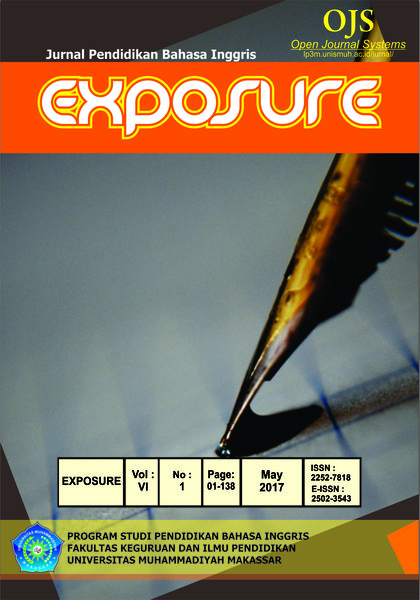IMPROVING THE STUDENTS’ ABILITY TO WRITE DESCRIPTIVE TEXTS THROUGH FOUR SQUARE WRITING METHOD
DOI:
https://doi.org/10.26618/exposure.v6i1.1065Abstrak
Writing is a difficult skill for the students at SMPN 26 Makassar. It could be seen from the result of a diagnostic test which showed the ability of the second year students of SMPN 26 Makassar in writing paragraphs was still poor. The students were unable to express their ideas well in making descriptive texts. The research used Classroom Action Research that consisted of planning, action, observation, and reflection. It conducted in two cycles in which each cycle comprised four meetings. The subjects of this research were 28 students of the second year students of SMPN 26 Makassar.The findings indicated that the students’ ability to write descriptive text in cycle 1 has not reached the score target because the mean score of the students was 66.52 that classified as “fairly good” whereas, In cycle 2 the students’ mean score was 75.26. It indicated that the score target has been reached and classified as “Good”. Therefore, the researcher suggested the English teacher apply Four Square Writing Method as one of the alternative ways of teaching writing subject in the classroom especially in teaching the descriptive text.
Referensi
Adelstein, M. E. Pival, J. G. 1980. The Writing Commitment. New York: Hartcount Brace java Novich. Inc.
Ahmad, Zahrowi. 2009. http://ahmadzahrowi. Wordpress. Com /2009 /03/ 16/descriptive-text/.Html.
Bram, Barli. 1995. Write Well Improving Writing Skills. Yogyakarta: Kanisius.
Byrne, Donn 1980. English Teaching perspective, Singapore: Longman. Unpublished.
Gay, L.R. 1981. Education Research Competencies for Analysis and Application. New York: Merrill Publishers Company.
Gould, S. J. 1999. Four Square Writing Method. Carthage, IL: Teaching and Learning Company. Harmer, J. 1987. The Practice of English Language Teaching. New York: Longman Inc.
Heaton, JB. 1988. Writing English Language Tests. New Edition. New York: Longman publishing.
Lester, F, (Ed.) 2007. Second Handbook of Research on Mathematics Teaching And Learning. Greenwich, CT: Information Age.
Lowenberg, P. H. (1991). English as an Additional Language in Indonesia. World Englishes, 10(1), pp. 127-138
McDougal, Little & Company. 1999. Basic Skill in English. The United States of America.
Oshima, Alice, and Ann Hogue. 1997. Introduction to Academic Writing. London and New York: Longman Group UK Limited.
Pincars. (1987). Definition of Writing. (Online), retrieved from (HTTP:www.text.edu./definition/writing.doc. Accessed 5th December 2002).
Sangkala, I. (2012). The Correlation between Students’ extraversion Personality and Their Writing Skill at Muhammadiyah University of Makassar (a descriptive study). Jurnal Pendidikan Bahasa dan Sastra Inggris, 1(2), 185-206.
Sudjana. 1990. Metode Stastistika. Bandung. PT Gramedia.
Syam, U. K., & Sangkala, I. (2014). Information Transfer Technique in Teaching Writing. Exposure: Jurnal Pendidikan Bahasa dan Sastra Inggris, 3(1), 97-106.
Temple, Charles A., Nathan, Ruth., Burris, Nancy., Temple, Frances. (1982). The Beginning of Writing. Second Edition. Copyright by Allyn and Bacon, Inc. The United States of America.
Wishon, George, and Burks. (1980). Let’s Write English. New York: Litton Education Publishing, Inc.
Unduhan
Diterbitkan
Terbitan
Bagian
Lisensi
Authors who publish with this journal agree to the following terms:
In order to assure the highest standards for published articles, a peer review policy is applied. In pursue of the compliance with academic standards, all parties involved in the publishing process (the authors, the editors and the editorial board and the reviewers) agree to meet the responsibilities stated below in accordance to the Journal publication ethics and malpractice statement.
Duties of Authors:
- The author(s) warrant that the submitted article is an original work, which has not been previously published, and that they have obtained an agreement from any co-author(s) prior to the manuscript’s submission;
- The author(s) should not submit articles describing essentially the same research to more than one journal;
- The authors(s) make certain that the manuscript meets the terms of the Manuscript Submission Guideline regarding appropriate academic citation and that no copyright infringement occurs;
- The authors(s) should inform the editors about any conflict of interests and report any errors they subsequently, discover in their manuscript.
Duties of Editors and the Editorial Board:
- The editors, together with the editorial board, are responsible for deciding upon the publication or rejection of the submitted manuscripts based only on their originality, significance, and relevance to the domains of the journal;
- The editors evaluate the manuscripts compliance with academic criteria, the domains of the journal and the guidelines;
- The editors must at all times respect the confidentiality of any information pertaining to the submitted manuscripts;
- The editors assign the review of each manuscript to two reviewers chosen according to their domains of expertise. The editors must take into account any conflict of interest reported by the authors and the reviewers.
- The editors must ensure that the comments and recommendations of the reviewers are sent to the author(s) in due time and that the manuscripts are returned to the editors, who take the final decision to publish them or not.
Authors are permitted and encouraged to post online a pre-publication manuscript (but not the Publisher’s final formatted PDF version of the Work) in institutional repositories or on their Websites prior to and during the submission process, as it can lead to productive exchanges, as well as earlier and greater citation of published work (see The Effect of Open Access). Any such posting made before acceptance and publication of the Work shall be updated upon publication to include a reference to the Publisher-assigned DOI (Digital Object Identifier) and a link to the online abstract for the final published Work in the Journal.

